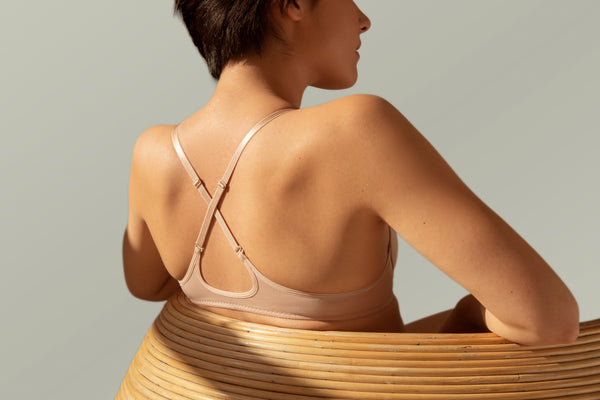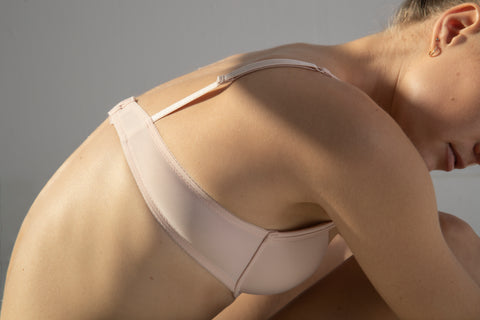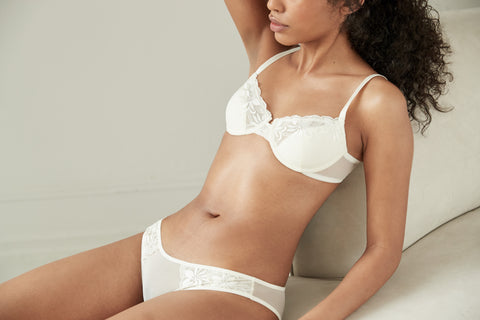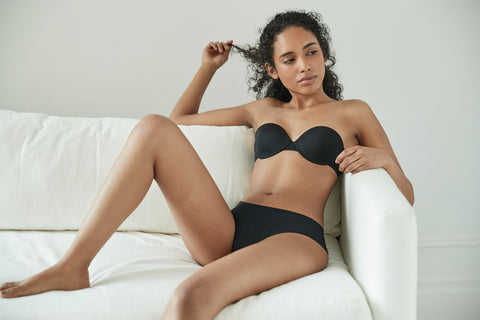Have you been buying the same bra size since high school?
Getting a fitting for your first bra is a right of passage for many women. But over time, our bodies change—as does our bra size. And if yours isn’t right, you might struggle with slipping straps or even get a double boob effect in some of your garments.
If you’re wondering how to measure for a bra so that you can finally adjust for an accurate fit, this is your guide. We’ll discuss the ways to find the right fit in the band, strap, and cup.
Basic Bra Measurements
To identify a basic sense of your fit, you’ll need two measurements:
- Band size
- Cup size
While it’s easy to measure your band size, cup size refers to the difference between your band measurement and bust circumference. But while bras come in standard sizes, breasts don’t, which can make it tricky to strike a balance between these two criteria for fit.
That’s why some estimates suggest that 80% of women are wearing the wrong bra size!
Next, we’ll take a closer look at both measurements and the best ways to troubleshoot an uncomfortable bra.
Band Size
The easiest way to take your band measurement is with a measuring tape. Place the tape directly underneath your bust and form a level, snug circle around your rib cage to measure your “underbust.” Round up or down to the nearest number, then add +4 to even measurements or +5 to odd.
For example, if your raw measurement is 30.5, round up to 31, add 5 for a 36 band size. For a raw measurement of 30 we would add 4, resulting in a 34 band size.
Many brands offer bras in even sizes (30, 32, 34, etc.). Luckily, hook and eye closures allow you to make adjustments if you’re in between sizes. Ideally, all bras should be started on the loosest clasp. This way, you can tighten the bra as the bra stretches. But what happens if you choose a smaller or larger band size? That all depends on how your current bra fits.
How to Measure Cup Size
As we’ve noted, your cup size isn’t an absolute measurement. Instead, it refers to the difference between your band (underbust) size and your bust size.
The next step for how to measure bra size is to use your measuring tape to take the circumference at the fullest part of your bust. Then, subtract your raw band measurement from your bust measurement. The difference determines your cup size as follows:
|
AAA |
1” |
|
AA |
2” |
|
A |
3” |
|
B |
4” |
|
C |
5” |
|
D |
6” |
Someone with a 28” raw band measurement and 30” bust would theoretically be an 32 AA, for example.
But as we’ve noted, many breasts fall in between measurements—and then there’s the issue of shape. Math can only get you so far. To find the right fit, you’ll also need to pay attention to the way your bra actually feels.
Where it Becomes Complicated
As we’ve already noted, band sizes tend to come in even numbers. If you have a 32.5” band measurement, you could try a 36” bra on an outer eyelet, or hook a 38” band on the second eyelet.
But once you add cup size to the mix, there can be even more uncertainty. For example, If your band size is 32.5” and your bust size is 34.5”, you could potentially try out all of the following options:
- 38AAA
- 38AA
- 36AAA
- 36AA
Every pair of breasts is unique in shape—from teardrop to rounded to pointed and beyond. Likewise, the A cups from two different manufacturers may be completely different sizes. Finally, minor variations between your right and left bust could make it even more complicated to determine right from wrong!
So what’s a gal to do?
Once you have your measurements, the next step is taking a thorough inventory of your fit.
The Straps Can Be the Canary in the Coal Mine
From magazine editorials and movies, it’s easy to get the idea that slipping bra straps are a common, coy occurrence. But if you find yourself adjusting your bra straps throughout the day, it could point to a bigger issue with your bra fit.
- Bra straps are supporting players. They help pull the bra cup snug against the body and provide additional support.
- However, they can be asked to carry more than their weight by a too-loose bra band or too-large cup.
If your bra straps are constantly slipping off your shoulders or you can slide more than a couple of fingers underneath your strap, there’s likely a deeper issue with the fit of your bra.
Assess Your Band Size
Your underbust circumference is important, but they can’t replace the most important measurement of all—how your bra feels. A well-fitting bra band lies in a level circle around your ribcage without creating pinching or allowing for slippage.
Your bra band may be too big if:
- You have to tighten the straps all the way to create adequate support
- You easily pull it inches away from your back
- Anytime a strap slips off your shoulder, the band begins to sag or slide
It may be too small if:
- You notice it digging into your ribcage
- You can’t wait to take your bra off at the end of the day
If you’re hooked on the middle eyelet, you can try adjusting your bra to the inner eyelet (if it feels too big) or the outer eyelet (if it feels too small).
But if the problem persists, it’s time to consider changing your band size. But when you go up or down by 2”, it will affect the volume of the overall cup. The AAs that served you well for so long may suddenly cause problems.
Assess Your Cup Size
Just like Goldilocks, there’s an option out there for you that’s just right. Your next step towards finding it is assessing the fit of your cups. It’s easy to tell if your cups are too small—you’ll get the infamous quadruple-boob affect from the bulge above the top of your cups.
On the other hand, tell-tale giveaways of a half-empty cup include:
- A gap between your breast and the cup
- Wrinkles in the padding of your bra
If you’ve switched from a 34AA to a 32AA to address a tight band, you might suddenly notice that your cups overflow.
To Make the Right Change, Find Your Sister Size
When you need to shift up or down a bra size, you might assume the go-to measurement is the band or cup. But it’s easy to end up with the wrong fit. You went down one band size, and now your boobs bulge. You went up a cup, and now your straps slide off.
Why is this happening?
When it comes to bra size, 32AA and 30AA are further apart than that single extra “A” suggests. Every change in band size entails an proportional change to the volume of the cup.
So how can you find the right fit? Refer to your bra’s sister size.
If your bra band is too big but the cups fit, shift from the size on the left of the chart to the sister size on the right. Likewise, if your band is too snug, try making a shift from right to left.
|
30AA |
28A |
|
30A |
28B |
|
32AAA |
30AA |
|
32AA |
30A |
|
32A |
30B |
|
34AAA |
32AA |
|
34AA |
32A |
|
34A |
32B |
|
36AAA |
34AA |
|
36AA |
34A |
|
36A |
34B |
Lulalu: The Perfect Fit for Smaller Busts
Petite women face additional challenges when shopping for the right bra size. Whether your narrow shoulders make it difficult to find the right straps or you’re in between cup sizes, you need bras that are specially designed to fit your smaller frame.
At Lulalu, we’re proud to be the go-to source for smaller bras. Our tools help you find your perfect fit, while our wide selection of styles helps you identify a bra for every outfit.
When it comes to bras, it’s okay to be a Goldilocks. And at Lualu, you can find a bra that fits just right. You can find a bra that you deserve.
Sources:
New York Times. Are 8 Out of 10 Women Really Wearing the Wrong Bra Size. https://www.nytimes.com/2019/07/10/style/lingerie-are-8-out-of-10-women-really-wearing-the-wrong-bra-size-a-bra-myth-busted.html
Image source: @nataliyakhan




